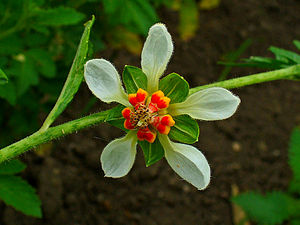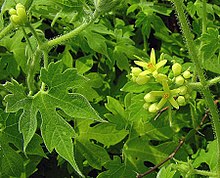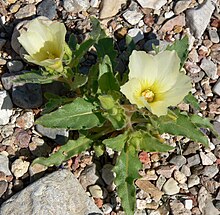Nettle family
| Nettle family | ||||||||||||
|---|---|---|---|---|---|---|---|---|---|---|---|---|

Loasa vulcanica , blossom |
||||||||||||
| Systematics | ||||||||||||
|
||||||||||||
| Scientific name | ||||||||||||
| Loasaceae | ||||||||||||
| Yuss. |
Flower nettle family (Loasaceae) are a family in the order of the dogwood-like (Cornales).
description

They are rightly called the nettle family because, on the one hand, many species have beautiful flowers, but, on the other hand, all species usually have numerous, very diverse and mostly rigid hairs, which in many species are very unpleasant stinging hairs . The stinging hairs are mostly used as an ornamental plant, which prevents us mostly annual cultivated species in gardens and parks.
Vegetative characteristics
All species of the family are annual or perennial, prostrate or upright, mostly herbaceous plants , occasionally woody plants: shrubs or small trees , rarely basal rosettes, climbing plants or lianas . They reach heights of growth of 5 centimeters up to 10 meters.
The mostly alternate and helically arranged leaves are usually divided into a petiole and a leaf blade. The leaf blades are usually simple or rarely composed. Stipules are missing.
Generative characteristics
The always hermaphrodite flowers are radial symmetry and usually five-fold (four to seven-fold) with a double flower envelope . The mostly five durable sepals are free. There are usually five petals available. In the often boat-shaped petals there is a tuft of stamens. The stamens curve up one after the other and the pollen is distributed explosively. In front of these clusters of stamens lie extremely complex and strikingly colored structures. These are the nectar-producing organs of the flowers, so-called nectaries ; these are the result of the coalescence of sterile stamens ( staminodes ). Depending on the genus, a different number of staminodes are involved in the formation of such a nectarium. The number of stamens varies among taxa: rarely five, usually 50 to 100. Most five (one or three to seven) fruit leaves are to a greater or lesser Upper permanent (unlike other families of the order) ovary grown (synkarp).
The capsule fruits can be club-shaped to spherical, in many cases they are twisted.
ecology
The pollination is usually by insects. They also attract many hover flies and bees in Central Europe. Pollination by field mice has been observed in one Loasa species in northern Argentina.
Locations
The types of Loasaceae family grow in completely different habitats: from the extremely dry Atacama Desert in southern Peru and northern Chile to the very humid cloud forests of northwestern Colombia .
Systematics and distribution
The Loasaceae family is distributed from North America through Mexico and Central to South America and occurs on the western Arabian Peninsula, Cape Verde, Africa and the Pacific islands. The center of diversity in the family is the Neotropic ; there they occur from California to Patagonia , especially in Peru, Chile and Mexico. The genus pillowia is found in Africa and Arabia, Plakothira in Polynesia .
The family of the nettle plants (Loasaceae) is divided into four subfamilies and contains about twenty genera with about 350 species :
- Subfamily Gronovioideae
(Rchb.) Link : It contains only three genera with only four species:
-
Cevallia Lag . : It contains only one species:
- Cevallia sinuata Lag .: It thrives at altitudes of 130 to 2000 meters in the US states of Arizona , New Mexico , Oklahoma and Texas and in the Mexican states of Chihuahua , Coahuila , Durango and Zacatecas .
-
Fuertesia Urb. : It contains only one type:
- Fuertesia dominguensis Urb. : This endemic occurs only on the island of Hispaniola .
- Gronovia L .: The only two species occur in the Neotropic.
-
Cevallia Lag . : It contains only one species:
- Subfamily Petalonychoideae Weigend : It contains only one genus:
- Subfamily Loasoideae : It is divided into two tribe :
- Tribe Loaseae:
- Aosa Weigend : About six species occur in eastern Brazil , one species occurs in Hispaniola and one species in Costa Rica .
- Blumenbachia Schrad. : The approximately twelve species occur in South America.
- Caiophora C.Presl (Syn .: Cajophora C.Presl ): The approximately 34 species thrive in the Andes of South America.
-
Chichicaste Weigend : It contains only one species:
- Chichicaste grandis (standl.) Weigend : It occurs from Costa Rica to northwestern Colombia .
- Huidobria Gay : The only two species occur only in northern Chile .
- Issenia R. Br. Ex Endl. : Of the only two species,one species occurs in southern Arabia , Somalia and Ethiopia , and one species occurs in southern Africa .
- Loasa Adans. : The 36 or so species are distributed from Mexico to South America.
- Nasa Weigend : The approximately 100 species are common in the Neotropic.
- Presliophytum (Urb. & Gilg) Weigend : The three or so species thrive only in the arid regions of western Peru.
- Scyphanthus Sweet : One or two species occur in Chile .
- Tribe Klaprothieae Urb. & Gilg : It contains only three genera with only six species:
- Klaprothia Kunth : The two species occur in tropical South America.
- Plakothira Florence : The three species only occur in the Marquesas .
-
Xylopodia Weigend : It contains only one species:
- Xylopodia klaprothioides Weigend : It occurs in Peru .
- Tribe Loaseae:
-
Mentzelioideae : It contains only three genera with about 110 species that are widespread in the New World:
- Mentzelia L .: The 95 or so species thrive in the warmer areas of the New World.
- Eucnide Zucc. : The approximately 14 species occur from the southwest and south-central USA through especially in Mexico to Guatemala .
-
Schismocarpus S.F.Blake : It contains only one species:
- Schismocarpus pachypus S.F.Blake : This endemic occurs only in the Mexican state of Oaxaca .
Individual evidence
- ↑ a b c d e Maximilian Weigend: Loasaceae. In: Klaus Kubitzki (Ed.): The Families and Genera of Vascular Plants . Volume 6: Flowering Plants, Dicotyledons: Celastrales, Oxalidales, Rosales, Cornales, Ericales . Springer, Berlin / Heidelberg / New York 2004, ISBN 3-540-06512-1 , pp. 239–254 (English, limited preview in Google Book Search).
- ↑ a b c d The Loasaceae family at DELTA . (English)
- ↑ a b c d e f g h i Larry Hufford: Loasaceae. - Same text online as the printed work , In: Flora of North America Editorial Committee (Ed.): Flora of North America North of Mexico , Volume 12 - Magnoliophyta: Vitaceae to Garryaceae , Oxford University Press, New York and Oxford, December 22, 2016 , ISBN 978-0-19-064372-0 .
- ↑ a b c d e f g h i j k l m n o David John Mabberley: Mabberley's Plant-Book. A portable dictionary of plants, their classification and uses. 3rd edition, Cambridge University Press 2008, ISBN 978-0-521-82071-4 .
Web links
- The Loasaceae page. (English)
- The family of Loasaceae in APWebsite . (English)




